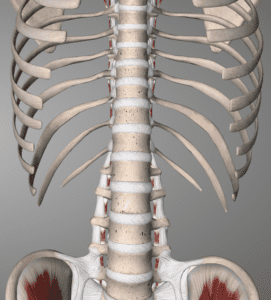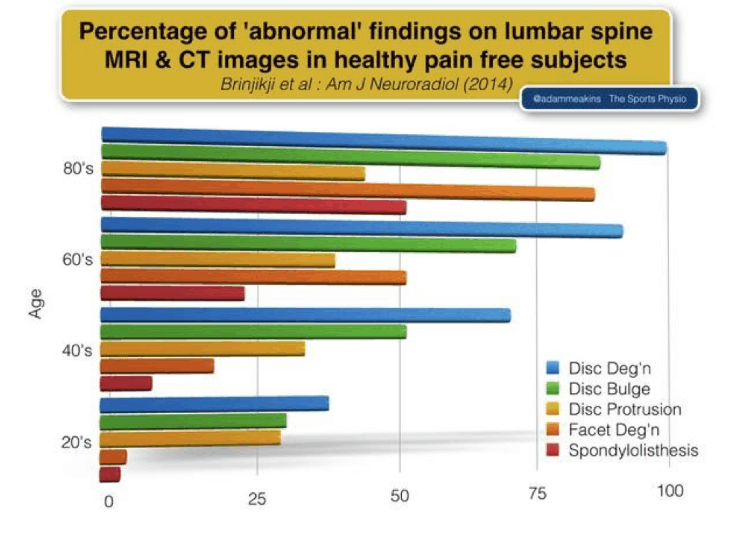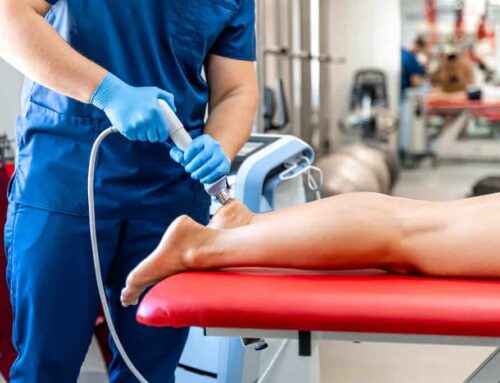Have you been told you have bulging discs? What does that even mean?
Read on to find out:
- What’s a bulging disc and who gets them
- How bulging discs can cause back, hip and leg pain
- What a disc bulge means for your future
- How working with an expert can help you
What’s a bulging disc and who gets them?
Your spine has multiple bones in it, and between each bone sits a cushion called a disc. That disc cushions the bones and helps absorb shock as you go about your day. When a disc protrudes outside its normal space between the bones, it’s considered ‘bulging’. You can check out our discussion on disc herniation for more details.
Almost everybody gets them! Bulging discs are extremely common in people WITHOUT any back pain. It appears that they may be part of the normal aging process. In fact, about 50% of people without any back pain under age 60, have a disc bulge. That percentage increases to almost 75% in folks over age 60. Again – these people have no pain, yet have some disc changes in the spine. That means that even if your MRI shows a disc problem, it may not be the cause of your pain. It also tells us that having low back pain doesn’t necessarily mean you need an MRI. Findings on the images often don’t correlate with what you’re feeling, and can even cause you unnecessary anxiety! Most of the time, low back pain can be safely addressed without any X-rays, MRIs, or CT scans.
(Thanks to The Sports Physio Adam Meakins for this awesome graphic)
How could bulging discs contribute to low back, hip or leg pain?
In the cases where a bulging disc is, in fact, causing pain, it can show up in various places. If the disc is irritating a nerve, then anywhere that nerve goes could hurt. So a disc issue could definitely be leading to discomfort you feel in the buttocks, down the leg or into the foot and ankle.
What does a disc bulge mean for my future?
A disc bulge is highly unlikely to change your future activities. Like we talked about above, lots of people have one and never know!
When you have low back or leg pain that’s caused by a disc bulge, temporary modifications in activities might be necessary to provide a more optimal environment for healing. Eventually, however, you’ll be able to get back to squatting, tying your shoes, and sitting. Incorporating some simple strategies, as suggested by an expert in low back pain, into your daily life can help prevent the issue from returning.
Whether your discs are bulging or not, if you have back pain and are looking to fix it for good, check out 5 steps to relief from back pain.
How can working with an expert in low back pain help me?
An expert in low back pain can determine if your pain is actually coming from a disc, or if it’s a from muscles, joints, or even poor movement patterns. Once the source is discovered, you’ll be guided through an individualized plan to address that source and get you back to the things you love without this issue coming back.
If you begin working with an expert and a disc issue is suspected, that doesn’t mean you’re doomed. Having a disc bulge doesn’t automatically mean that you’ll have surgery. In fact, the majority of people with a bulging disc never need it. The prognosis is good over a few weeks to months – disc bulges can actually shrink and heal on their own! An expert in low back pain will guide you through the process to optimize this healing.
To find out more about how one of our experts can help you, head over to physical therapy for low back pain.
Are you ready to get over your disc bulge diagnosis and move on with your life? Click here to see if we have availability to start working with you.
Blog image: Essential Anatomy 5.0.5







